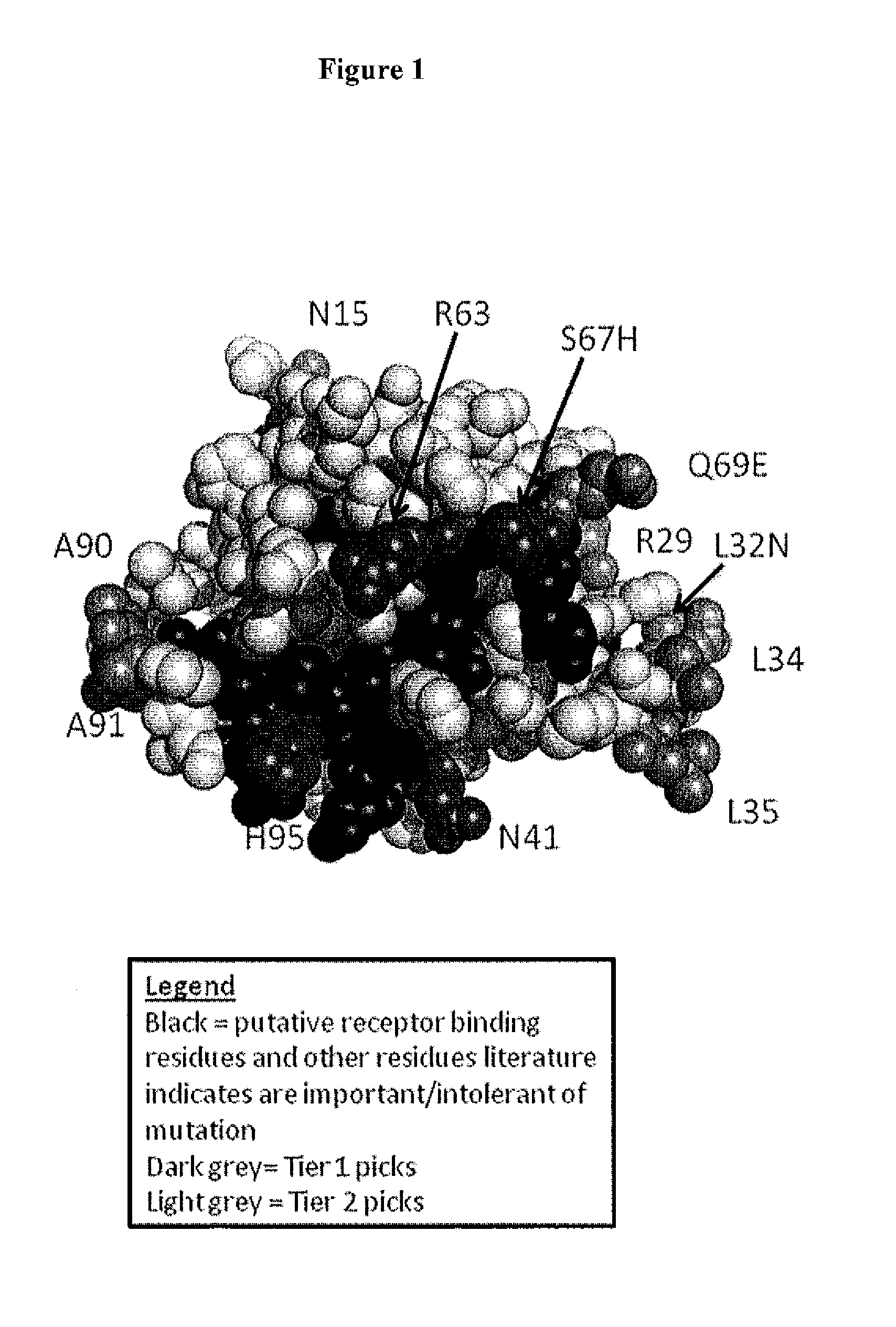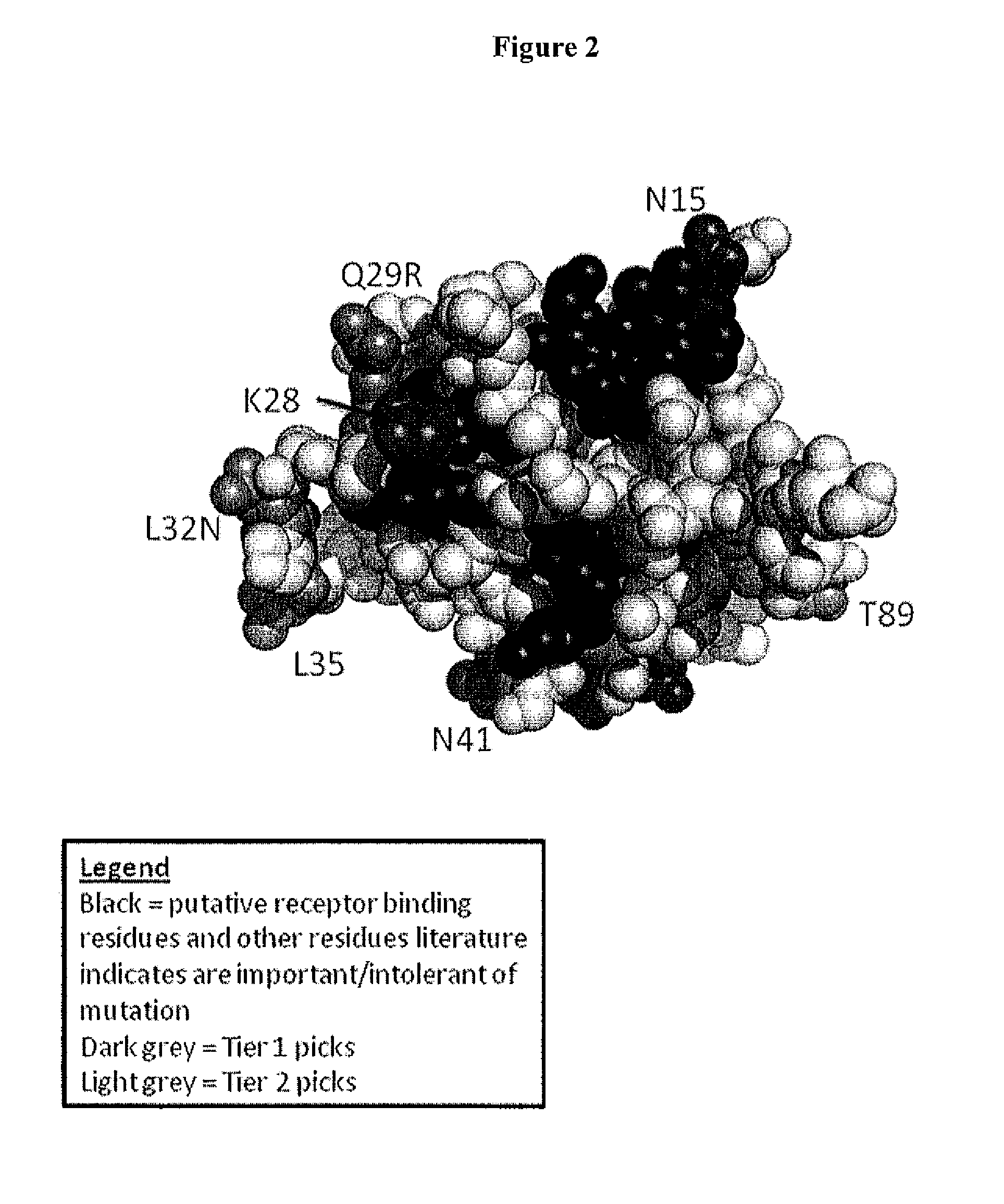Interleukin-3 Polypeptide Conjugates and Their Uses
a technology of interleukin-3 and polypeptide, which is applied in the direction of peptides/protein ingredients, animal/human proteins, peptides/protein ingredients, etc., can solve the problems of limited overall survival benefit of chemotherapy, radiation and other modalities including newer targeted therapies, exert toxic effects on cancer cells, and chemotherapeutic agents are notoriously toxic, so as to increase the therapeutic half-life
- Summary
- Abstract
- Description
- Claims
- Application Information
AI Technical Summary
Benefits of technology
Problems solved by technology
Method used
Image
Examples
example 1
[0671]This example describes expression methods used for IL-3 polypeptides comprising a non-natural amino acid. Host cells are transformed with constructs for orthogonal tRNA, orthogonal aminoacyl tRNA synthetase, and a polynucleotide encoding IL-3 polypeptide from SEQ ID NO: 3, or SEQ ID NOs: 1, 2, comprising a selector codon.
Preparation
[0672]Sterile base, 5.5 M potassium carbonate (0.5 L), is prepared and sterilized by steam or filtration. Sterile 25% v / v polyalkylene defoamer, such as Struktol J673 (0.1 L), was prepared and sterilized by steam. Concentrated feed medium (4 L, defined) was prepared and filter sterilized into a sterile feed tank or bioprocess bag.
[0673]The fermentor is set-up. It is sterilized with 3.91 L Base Salts solution. The fermentor is brought to the following conditions: temperature=37° C., pH=6.9, 1 VVM air. 0.092 L concentrated feed medium is added to the fermentor. 4 mL of 50 mg / mL kanamycin was added.
[0674]Solutions of glycerol and ar...
example 2
IL-3 Purification, PEGylation, and IL-3 Dimer-PEG Purification Process Cytoplasmic Preparation from E. coli
1. Cell Lysis & Oxidation of IL-3
[0677]An 850 gram bacterial cell pellet is resuspended in 2550 ml (3 volumes) of 20 mM TRIS, pH 8.5 lysis buffer to obtain a mixture that is 25% solid. Approximately four liters of culture in fermentation broth will yield this 850 gram bacterial pellet. The mixture is stirred at room temperature for 30-60 minutes, and the suspension is passed through the Microfluidizer processor twice with cooling at 15,000 psi. The lysate is centrifuged at 13,500×g for 45 minutes in a JA10 rotor at 4° C., and the supernatant is collected. Freshly prepared 0.1 M GSSG (FW 612.6) can be added to obtain a molar ratio of GSSG to IL-3, approximately 16. The combination is stirred to mix well, and the pH is adjusted to 7.2-7.4 with 1 M NaOH. After the mixture is stirred overnight at 4° C., it can be diluted until its conductivity reaches 1.6-1.9 mS / cm with water. At ...
example 3
[0707]This example details cloning and expression of an IL-3 including a non-naturally encoded amino acid in E. coli. This example also describes methods to assess the biological activity of modified IL-3.
[0708]Methods for cloning IL-3 are known to those of ordinary skill in the art. Polypeptide and polynucleotide sequences for IL-3 and cloning of these polypeptides into host cells as well as purification of IL-3 are known in the art and are also detailed in Goeddel et al., Nucleic Acids Res. 8, 4057 (1980) which is incorporated by reference in their entirety herein. Additional IL-3 sequences, expression, and techniques are described in US Patent Publication Number 20020058018 entitled “Novel interleukin-3 and uses thereof”, which is also hereby incorporated by reference in its entirety.
[0709]The amino acids encoding IL-3 without a leader or signal sequence is shown as SEQ ID NO: 3. An introduced translation system that comprises an orthogonal tRNA (O-tRNA) and an orthogonal aminoac...
PUM
| Property | Measurement | Unit |
|---|---|---|
| time | aaaaa | aaaaa |
| body weight | aaaaa | aaaaa |
| body weight | aaaaa | aaaaa |
Abstract
Description
Claims
Application Information
 Login to View More
Login to View More - R&D
- Intellectual Property
- Life Sciences
- Materials
- Tech Scout
- Unparalleled Data Quality
- Higher Quality Content
- 60% Fewer Hallucinations
Browse by: Latest US Patents, China's latest patents, Technical Efficacy Thesaurus, Application Domain, Technology Topic, Popular Technical Reports.
© 2025 PatSnap. All rights reserved.Legal|Privacy policy|Modern Slavery Act Transparency Statement|Sitemap|About US| Contact US: help@patsnap.com



